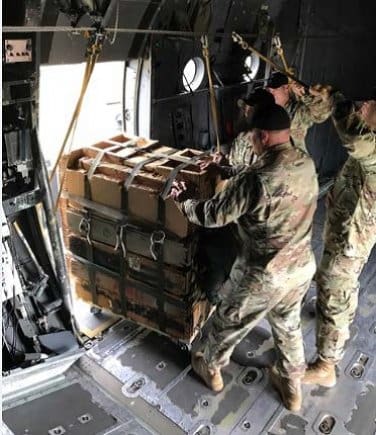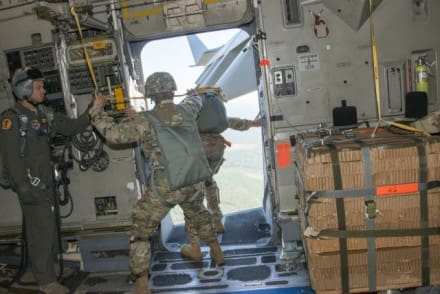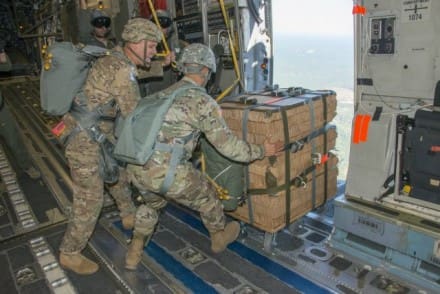FORT BRAGG, North Carolina — 82nd Airborne Division troopers here are wrapping up testing of the Caster Assisted A-Series Delivery System (CAADS), which involves delivering mission essential supplies and munitions to ground troops.
Soldiers from Company A, 2nd Battalion, 325th Airborne Infantry Regiment, 2nd Brigade Combat Team teamed up with subject matter experts from the United States Army Advanced Airborne School (USAAS).

Paratroopers from the U.S. Army Advanced Airborne School develop Techniques Tactic and Procedures prior to testing with the U.S. Army Operational Test Command’s Airborne and Special Operations Test Directorate. (Photo Credit: Mr. Michael A. Zigmond, Airborne and Special Operations Test Directorate, U.S. Army Operational Test Command Public Affairs.)
With the Fort Bragg-based U.S. Army Operational Test Command’s (USAOTC) Airborne and Special Operations Test Directorate (ABNSOTD), they successfully rigged, dropped, and recovered the CAADS door bundles during operational testing on Sicily Drop Zone.
The 82nd Airborne Division is part of the XVIII Airborne Corps, and is the Army’s most strategically mobile division.

Capt. Matthew P. Carstensen, (right) Commander, Headquarters & Headquarters Co. 2nd Battalion, 505th Parachute Infantry Regiment, 3rd Brigade Combat Team, conducts a door check prior to exiting the first Caster Assisted A-Series Delivery System from a U.S. Air Force C-17 aircraft. (Photo Credit: Mr. Michael A. Zigmond, Airborne and Special Operations Test Directorate, U.S. Army Operational Test Command Public Affairs.)
82nd Airborne Division Commander, Maj. Gen. Erik Kurilla, said, “The 82nd Airborne Division is the elite Airborne infantry division of the United States Army, specializing in parachute assault operations into denied areas.”
Kurilla wants to be able to deploy three CAADS door bundles per paratroop door. Bundles can weigh up to 500 pounds of cargo and be airdropped from a variety of Department of Defense (DoD) transport aircraft to support the Global Response Force.

Sgt. 1st Class Miguel A. Amadis of Company A, 2nd Battalion, 325th Airborne Infantry Regiment, 2nd Brigade Combat Team, positions the Caster Assisted A-Series Delivery System in the door of a U.S. Air Force C-17 aircraft before deployment onto Sicily Drop Zone. (Photo Credit: Mr. Michael A. Zigmond, Airborne and Special Operations Test Directorate, U.S. Army Operational Test Command Public Affairs.)
The current door bundle limit without CAADS is two bundles per door per pass.
Currently, there is no standardized aerial delivery system in the Department of Defense (DoD) inventory that employs the dolly-assisted method, but other countries like France employ a similar system.
CAADS is a platform built of plywood, a brake, and six caster wheels which allow the door bundle to roll across the aircraft floor, speeding airdrop deployment.
Testing demonstrated safe deployment of door bundles using CAADS to improve the ability of Soldiers deploying the bundles while reducing exit time. The increased speed allows for additional bundles per pass.
The efficiency of the CAADS concept provides the capability of exiting more door bundles per pass, per aircraft — all increasing the amount of supplies on the ground to the paratroopers during their critical 12 hour initial entry phase.
Sgt. 1st Class Miguel A. Amadis of Company A, 2nd Battalion, 325th Airborne Infantry Regiment, 2nd Brigade Combat Team said, “I like the CAADS a lot. It was easy to push, easy to set up at the door, and it will be very useful for the upcoming missions.”
One Airborne unit commander said he liked CAADS’ simplistic design and concept, which can seriously lessen the physical wear and tear on the average paratrooper.
“The castor’s one free axle made the rotation into the door easy, but still kept two axles locked, which maintained control as the container exited the door and entered the slip stream,” said Capt. Matthew P. Carstensen, Commander, Headquarters and Headquarters Company, 2nd Battalion, 505th Parachute Infantry Regiment, 3rd Brigade Combat Team.
“I felt that the concern of jarring the container in the doorway was safely mitigated by those locked axles,” he added. “Looking at future application, a container of this size and capacity can significantly increase the combat power and lethality delivered onto a hostile drop zone on the first pass.”
According to Sgt. 1st Class Martin L. Ross, ABNSOTD Test NCO, operational testing is OTC’s opportunity to contribute to Army readiness.
“Anything less compromises the Army’s ability to provide the forces that fight and win the Nation’s wars,” he said.
“Operational testing is about Soldiers,” said Col. Bradley F. Mock, Director of the ABNSOTD. “It is about making sure that the systems developed are effective in a Soldier’s hands and suitable for the environments in which Soldiers train and fight. Operational testing is OTCs opportunity to contribute to readiness; anything less compromises the Army’s ability to provide the forces that fight and win the Nation’s wars.”
The ABNSOTD Test Division chief explained how test units incorporate systems under test into their actual missions and training requirements.
“Leaders of units involved in testing have the first look at new systems, which may also drive changes to operations and doctrine,” said Lt. Col. Gregory Oquendo. “Tests are unit-led, which translates into coordinated control under realistic operational environment scenarios.”
Other tests underway at ABNSOTD include the Advanced Medium Mobile Power Sources (AMMPS) 30K generator which will replace the relatively short-lived TQG (Tactical Quiet Generator) program and airdrop certification of the Light Armored Vehicle (LAV-25A2) Mobile Protective Firepower (MPF). Highly-instrumented test drops by Airborne and Special Operations Test Directorate (ABNSOTD) will help test overall airdrop survivability of the vehicles.
By Mr. James (J.C.) Cochran, Military Test Plans Analyst, Airborne and Special Operations Test Directorate, U.S. Army Operational Test Command Public Affairs.


In other news, the 82nd Airborne Division discovers new uses for the time tested furniture dolly. Harbor Freight runs deals on these all the time.
Why wouldn’t you use the ramp and the onboard roller system? I mean this is a good idea, but door bundles were always slow.
Believe me, I’ve done door bundles followed by pax door exits (C-130/141), ramp sleds with pax door exits (MC-130), ramp pallets with pax ramp exits (C-130). That’s a C17, you could put 20-30 of those bundles on the ramp and exit jumpers from the doors.
Because if you lower the ramp on a C-130 you lose the ability to use one static line cable per door. So, you’re reduced to 40 total jumpers.
Back in the 80’s we apparatus called the WEDGE, it was literally a wedged shaped platform will a roller bed that sat on the ramp. Six large bundles could be staged on it. With the ramp lowered level the loads would sit at around a 30 degree angle,
Green light goes on, bundles are released damn near in the blink of an eye, and then you can send the jumpers. But, only 20 per door.
One problem was recognised pretty quickly. Kept seeing incidences of bundles shifting during low level flights. And, bundles kept failing to roll off the WEDGE, which meant no one could exit until the loads were secured and the ramps closed.
Needless to say, any “great idea” which has a likelihood to subject a/c to multiple passes while failing to deliver mission essential ammo & equipment tend to be abandoned pretty quickly.
Disaster waiting to happen. What happens if the cargo doesn’t get a good vigorous exit, up 6″ out 36″? It’s not like a man’s body, it won’t crumple up like a ragdoll against the skin of the aircraft. I’m talking about potentially dozens, even HUNDREDS of dollars worth of damage if one of these loads bangs the side of the bird.
You have absolutely no experience in pushing door bundles do you?
“Up 6? out 36?” LOL.
Jumper don’t even exit “6? out 36?” anymore. They’ve been simply walking off the jump platform at a 45 degree angle for a couple decades now.
Eh shouldn’t be exiting at 45* anymore. Haven’t since 2012, at least.
So it’s a door bundle on a shopping cart? Way to innovate, Deuce.
Airborne All The Way
so these things don’t get hung up in the tiedown ring recesses on the airplane?
The wheels on the cart used by the blackhats in the (parked) C-130 definitely look small enough to get stuck.
The wheels on the cart in the actual operational photos taken in the (airborne) C-17 are larger and wider.
No quotes from the USAF Load Masters…
Haaaaa, the guys say it works and improves their capability, the internet says it won’t! Hilarious at best.
Yeah, its the internet’s fault – just like Parkland was the AR-15’s fault…
Points for ingenuity but man, you’d think in the 21st century we’d have a ramp-based solution.
If I saw this without ever having jumped from C-17s (after being nearly murdered by C-141s) I’d call this evidence that design engineers are completely ignoring the whole parachute insertion piece of the air transport mission. I’m thinking (hoping?) this is proof of a doctrinal concept to drive development of a more refined ramp-based solution.
Also, we don’t like to admit this but there are JMs out there who can barely get a stick of humans out the door. I hope JMs who don’t have the privilege of working directly with ABNSOTD get the training they need to do this safely.
Who knew that that it is easier to roll things than to drag them. What will these scientists think of next? Perhaps a mat with different conclusion on it that you can jump to…